Properties of the Long-Term Oscillations in the Middle Atmosphere Based on Observations from TIMED/SABER Instrument and FPI over Kelan
Abstract
:1. Introduction
2. Data and Method
2.1. TIMED/SABER Temperature Data
2.2. FPI Data
2.3. Analysis Methods
3. Lomb–Scargle Spectral Analysis
4. Semiannual Oscillation (SAO)
5. The Lower Mesospheric Inversion Layer (MIL)
6. The Triennial Oscillation (TO)
7. The Long-Term Variations Observed by FPI
8. Conclusions
Acknowledgments
Author Contributions
Conflicts of Interest
References
- Swinbank, R.; Ortland, D.A. Compilation of wind data for the Upper Atmosphere Research Satellite (UARS) Reference Atmosphere Project. J. Geophys. Res. 2003, 108, 1703–1708. [Google Scholar] [CrossRef]
- Fleming, E.L.; Chandra, S.; Barnett, J.J.; Corney, M. Zonal mean temperature, pressure, zonal wind and geopotential height as functions of latitude. Adv. Space Res. 1990, 10, 11–59. [Google Scholar] [CrossRef]
- Remsberg, E.E.; Bhatt, P.P.; Deaver, L.E. Seasonal and longer-term variations in middle atmosphere temperature from HALOE on UARS. J. Geophys. Res. 2002, 107, ACL 18:1–ACL 18:13. [Google Scholar] [CrossRef]
- Xu, J.; Liu, H.L.; Yuan, W.; Smith, A.K.; Roble, R.G.; Mertens, C.J.; Russell, J.M.; Mlynczak, M.G. Mesopause structure from Thermosphere, Ionosphere, Mesosphere, Energetics, and Dynamics (TIMED)/Sounding of the Atmosphere Using Broadband Emission Radiometry (SABER) observations. J. Geophys. Res. 2007, 112, 139–155. [Google Scholar] [CrossRef]
- Mayr, H.G.; Mengel, J.G.; Chan, K.L.; Huang, F.T. Middle atmosphere dynamics with gravity wave interactions in the numerical spectral model: Zonal-mean variations. J. Atmos. Solar-Terr. Phys. 2010, 72, 807–828. [Google Scholar] [CrossRef]
- Holton, J.R.; Wehrbein, W.M. A numerical model of the zonal mean circulation of the middle atmosphere. Pure Appl. Geophys. 1980, 118, 284–306. [Google Scholar] [CrossRef]
- Hirota, I. Observational evidence of the semiannual oscillation in the tropical middle atmosphere—A review. Pure Appl. Geophys. 1980, 118, 217–238. [Google Scholar] [CrossRef]
- Meyer, W.D. A diagnostic numerical study of the semiannual variation of the zonal wind in the tropical stratosphere and mesosphere. J. Atmos. Sci. 1970, 27, 820–830. [Google Scholar] [CrossRef]
- Hamilton, K. Dynamics of the stratospheric semi-annual oscillation. J. Meteorol. Soc. Jpn. 1986, 64, 227–244. [Google Scholar]
- Hamilton, K.; Wilson, R.J.; Mahlman, J.D.; Umscheid, L.J. Climatology of the SKYHI troposphere-stratosphere-mesosphere general circulation model. J. Atmos. Sci. 1995, 52, 5–43. [Google Scholar] [CrossRef]
- Hopkins, R.H. Evidence of polar-tropical coupling in upper stratospheric zonal wind anomalies. J. Atmos. Sci. 1975, 32, 712–719. [Google Scholar] [CrossRef]
- Hirota, I. Equatorial waves in the upper stratosphere and mesosphere in relation to the semiannual oscillation of the zonal wind. J. Atmos. Sci. 1978, 35, 714–722. [Google Scholar] [CrossRef]
- Andrews, D.G.; Holton, J.R.; Leovy, C.B. Middle Atmosphere Dynamics; Elsevier: New York, NY, USA, 1987; p. 489. [Google Scholar]
- Richter, J.H.; Garcia, R.R. On the forcing of the Mesospheric Semi-Annual Oscillation in the Whole Atmosphere Community Climate Mode. Geophys. Res. Lett. 2006, 33, 313–324. [Google Scholar] [CrossRef]
- Dunkerton, T.J. Theory of the mesopause semiannual oscillation. J. Atmos. Sci. 1982, 39, 2681–2690. [Google Scholar] [CrossRef]
- Sassi, F.; Garcia, R.R. The role of equatorial waves forced by convection in the tropical semiannual oscillation. J. Atmos. Sci. 1997, 54, 1925–1942. [Google Scholar] [CrossRef]
- Lindzen, R.S.; Holton, J.R. A theory of the quasi-biennial oscillation. J. Atmos. Sci. 1968, 25, 1095–1107. [Google Scholar] [CrossRef]
- Plumb, R.A. The interaction of two internal waves with the mean flow: Implications for the theory of the quasi-biennial oscillation. J. Atmos. Sci. 1977, 34, 1847–1858. [Google Scholar] [CrossRef]
- Baldwin, M.P.; Gray, L.J.; Dunkerton, T.J.; Hamilton, K.; Haynes, P.H.; Randel, W.J.; Holton, J.R.; Alexander, M.J.; Hirota, I.; Horinouchi, T.; et al. The quasi-biennial oscillation. Rev. Geophys. 2001, 39, 179–229. [Google Scholar] [CrossRef]
- Zhu, X.; Yee, J.H.; Cai, M.; Swartz, W.H.; Coy, L.; Aquila, V.; Garcia, R.; Talaat, E.R. Diagnosis of Middle-Atmosphere Climate Sensitivity by the Climate Feedback–Response Analysis Method. J. Atmos. Sci. 2016, 73, 3–23. [Google Scholar] [CrossRef]
- Drob, D.P.; Emmert, J.T.; Crowley, G.; Picone, J.M.; Shepherd, G.G.; Skinner, W.; Meriwether, J.W. An empirical model of the Earth’s horizontal wind fields: HWM07. J. Geophys. Res. 2008, 113, A12304. [Google Scholar] [CrossRef]
- Mingalev, I.V.; Mingalev, V.S.; Mingaleva, G.I. Numerical Simulation of the Global Neutral Wind System of the Earth’s Middle Atmosphere for Different Seasons. Atmosphere 2012, 3, 213–228. [Google Scholar] [CrossRef]
- Clancy, R.T.; Rusch, D.W.; Callan, M.T. Temperature minima in the average thermal structure of the middle mesosphere (70–80 km) from analysis of 40- to 92-km SME global temperature profiles. J. Geophys. Res. 1994, 99, 19001–19020. [Google Scholar] [CrossRef]
- Huang, F.T.; Mayr, H.G.; Reber, C.A.; Russell, J.M.; Mlynczak, M.; Mengel, J.G. Stratospheric and mesospheric temperature variations for the quasi-biennial and semiannual (QBO and SAO) oscillations based on measurements from SABER (TIMED) and MLS (UARS). Ann. Geophys. 2006, 24, 2131–2149. [Google Scholar] [CrossRef]
- Xu, J.; Smith, A.K.; Yuan, W.; Liu, H.L.; Qian, W.; Mlynczak, M.G.; Russell, J.M. Global structure and long-term variations of zonal mean temperature observed by TIMED/SABER. J. Geophys. Res. 2007, 112, 177–180. [Google Scholar] [CrossRef]
- Remsberg, E.E.; Marshall, B.T.; Garcia-Comas, M.; Krueger, D.; Lingenfelser, G.S.; Martin-Torres, J.; Mlynczak, M.G.; Russell, J.M.; Smith, A.K.; Zhao, Y.; Brown, C. Assessment of the quality of the Version 1.07 temperature-versus-pressure profiles of the middle atmosphere from TIMED/SABER. J. Geophys. Res. 2008, 113, 1641–1653. [Google Scholar] [CrossRef]
- Dou, X.; Li, T.; Xu, J.; Liu, H.L.; Xue, X.; Wang, S.; Leblanc, T.; Mcdermid, I.S.; Hauchecorne, A.; Keckhut, P. Seasonal oscillations of middle atmosphere temperature observed by Rayleigh lidars and their comparisons with TIMED/SABER observations. J. Geophys. Res. 2009, 114, 311. [Google Scholar] [CrossRef]
- Hocking, W.K. Temperatures Using radar-meteor decay times. Geophys. Res. Lett. 1999, 26, 3297–3300. [Google Scholar] [CrossRef]
- Sheng, Z.; Jiang, Y.; Wan, L.; Fan, Z.Q. A Study of Atmospheric Temperature and Wind Profiles Obtained from Rocketsondes in the Chinese Midlatitude Region. J. Atmos. Ocean. Technol. 2015, 32, 722–735. [Google Scholar] [CrossRef]
- Yu, T.; Huang, C.; Zhao, G.; Mao, T.; Wang, Y.; Zeng, Z.; Wang, J.; Xia, C. A preliminary study of thermosphere and mesosphere wind observed by Fabry-Perot over Kelan, China. J. Geophys. Res. 2014, 119, 4981–4997. [Google Scholar] [CrossRef]
- Yao, X.; Yu, T.; Zhao, B.; Yu, Y.; Liu, L.; Ning, B.; Wan, W. Climatological modeling of horizontal winds in the mesosphere and lower thermosphere over a mid-latitude station in China. Adv. Space Res. 2015, 56, 1354–1365. [Google Scholar] [CrossRef]
- Mertens, C.J.; Mlynczak, M.G.; Manuel, L.P.; Wintersteiner, P.P.; Picard, R.H.; Winick, J.R.; Gordley, L.L.; Russell, J.M. Retrieval of Mesospheric and Lower Thermospheric Kinetic Temperature from Measurements of CO2 15 Micrometers Earth Limb Emission under Non-LTE Conditions. Geophys. Res. Lett. 2001, 28, 1391–1394. [Google Scholar] [CrossRef]
- Mertens, C.J.; Schmidlin, F.J.; Goldberg, R.A.; Remsberg, E.E.; Dean, P.W.; Russell, J.M.; Mlynczak, M.G.; Manuel, L.P.; Wintersteiner, P.P.; Picard, R.H. SABER observations of mesospheric temperatures and comparisons with falling sphere measurements taken during the 2002 summer MaCWAVE campaign. Geophys. Res. Lett. 2004, 31, 445–446. [Google Scholar] [CrossRef]
- Fan, Z.Q.; Sheng, Z.; Shi, H.Q.; Yi, X.; Jiang, Y.; Zhu, E.Z. Comparative Assessment of COSMIC Radio Occultation Data and TIMED/SABER Satellite Data over China. J. Appl. Meteorol. Climatol. 2015, 54, 1931–1943. [Google Scholar] [CrossRef]
- Mcdonald, A.J.; Baumgaertner, A.J.G.; Fraser, G.J.; George, S.E.; Marsh, S. Empirical Mode Decomposition of the atmospheric wave field. Ann. Geophys. 2007, 25, 255–270. [Google Scholar] [CrossRef]
- Yuan, W.; Xu, J.Y.; Ma, R.P.; Wu, Q.; Jiang, G.Y.; Gao, H.; Liu, X.; Chen, S.Z. First observation of mesospheric and thermospheric winds by a Fabry-Perot interferometer in China. Chin. Sci. Bull. 2010, 55, 4046–4051. [Google Scholar] [CrossRef]
- Grubbs, F.E. Procedures for detecting outlying observations in samples. Technometrics 1969, 11, 1–21. [Google Scholar] [CrossRef]
- Press, W.H.; Teukolsky, S.A.; Vetterling, W.T.; Flannery, B.P. Numerical Recipes in Fortran 77, 2nd ed.; Cambridge University Press: New York, NY, USA, 1992; pp. 569–577. [Google Scholar]
- Torrence, C.; Compo, G.P. A Practical Guide to Wavelet Analysis. Bull. Am. Meteorol. Soc. 1998, 79, 61–78. [Google Scholar] [CrossRef]
- Lomb, N.R. Least-squares frequency analysis of unequally spaced data. Astrophys. Space Sci. 1976, 39, 447–462. [Google Scholar] [CrossRef]
- Huang, F.T.; Mayr, H.G.; Russell, J.M., III; Mlynczak, M.G. Ozone and temperature decadal responses to solar variability in the mesosphere and lower thermosphere, based on measurements from SABER on TIMED. Ann. Geophys. 2016, 34, 29–40. [Google Scholar] [CrossRef]
- Clemesha, B.; Takahashi, H.; Simonich, D.; Gobbi, D.; Batista, P. Experimental evidence for solar cycle and long-term change in the low-latitude MLT region. J. Atmos. Terr. Phys. 2005, 67, 191–196. [Google Scholar] [CrossRef]
- Kane, R.P.; Buriti, R.A. Latitude and Altitude Dependence of the Interannual Variability and Trends of Atmospheric Temperatures. Pure Appl. Geophys. 1997, 149, 775–792. [Google Scholar] [CrossRef]
- Belmont, A.D.; Dartt, D.G.; Nastrom, G.D. Periodic variations in stratospheric zonal wind from 20 to 65 km, at 80 N to 70 S. Q. J. R. Meteorol. Soc. 1974, 100, 203–211. [Google Scholar]
- Garcia, R.R.; Dunkerton, T.J.; Lieberman, R.S.; Vincent, R.A. Climatology of the semiannual oscillation, of the tropical middle atmosphere. J. Geophys. Res. 1997, 102, 26019–26032. [Google Scholar] [CrossRef]
- Meriwether, J.W.; Gardner, C.S. A review of the mesosphere inversion layer phenomenon. J. Geophys. Res. 2000, 105, 12405–12416. [Google Scholar] [CrossRef]
- Gan, Q.; Zhang, S.D.; Yi, F. TIMED/SABER observations of lower mesospheric inversion layers at low and middle latitudes. J. Geophys. Res. 2012, 117, 134–142. [Google Scholar] [CrossRef]
- Reid, G.C. Seasonal and interannual temperature variations in the tropical stratosphere. J. Geophys. Res. 1994, 99, 18923–18932. [Google Scholar] [CrossRef]
- Randel, W.J.; Garcia, R.R.; Calvo, N.; Dan, M. ENSO influence on zonal mean temperature and ozone in the tropical lower stratosphere. Geophys. Res. Lett. 2009, 36, 172–173. [Google Scholar] [CrossRef]
- Seidel, D.J.; Li, J.; Mears, C.; Moradi, I.; Nash, J.; Randel, W.J.; Saunders, R.; Thompson, D.W.J.; Zou, C.Z. Stratospheric temperature changes during the satellite era. J. Geophys. Res. 2016, 121, 664–681. [Google Scholar] [CrossRef]
- Wolter, K.; Timlin, M.S. El Nino/Southern Oscillation behaviour since 1871 as diagnosed in an extended multivariate ENSO index (MEI.ext). Int. J. Climatol. 2011, 31, 1074–1087. [Google Scholar] [CrossRef]
- Garcia-Herrera, R.; Calvo, N.; Garcia, R.R.; Giorgetta, M.A. Propagation of ENSO temperature signals into the middle atmosphere: A comparison of two general circulation models and ERA-40 reanalysis data. J. Geophys. Res. 2006, 111, 831–846. [Google Scholar] [CrossRef]
- Xu, J.Y.; Smith, A.K.; Liu, H.L.; Yuan, W.; Wu, Q.; Jiang, G.; Mlynczak, M.G.; Russell, J.M.; Franke, S.J. Seasonal and quasi-biennial variations in the migrating diurnal tide observed by Thermosphere, Ionosphere, Mesosphere, Energetics and Dynamics (TIMED). J. Geophys. Res. 2009, 114, 267–275. [Google Scholar] [CrossRef]
- Yuan, W.; Liu, X.; Xu, J.Y.; Zhou, Q.; Jiang, G.; Ma, R. FPI observations of nighttime mesospheric and thermospheric winds in China and their comparisons with HWM07. Ann. Geophys. 2013, 31, 1365–1378. [Google Scholar] [CrossRef]
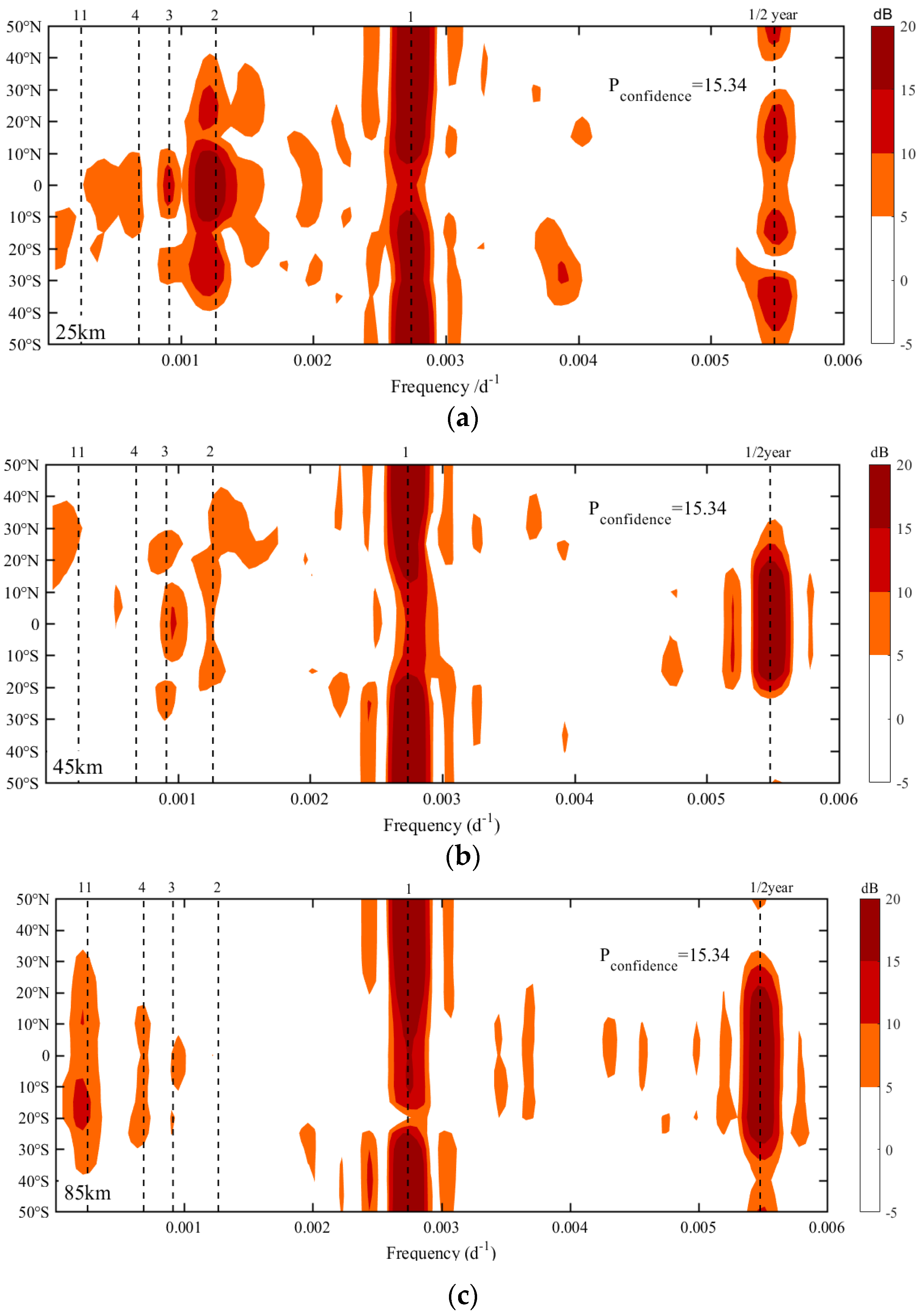
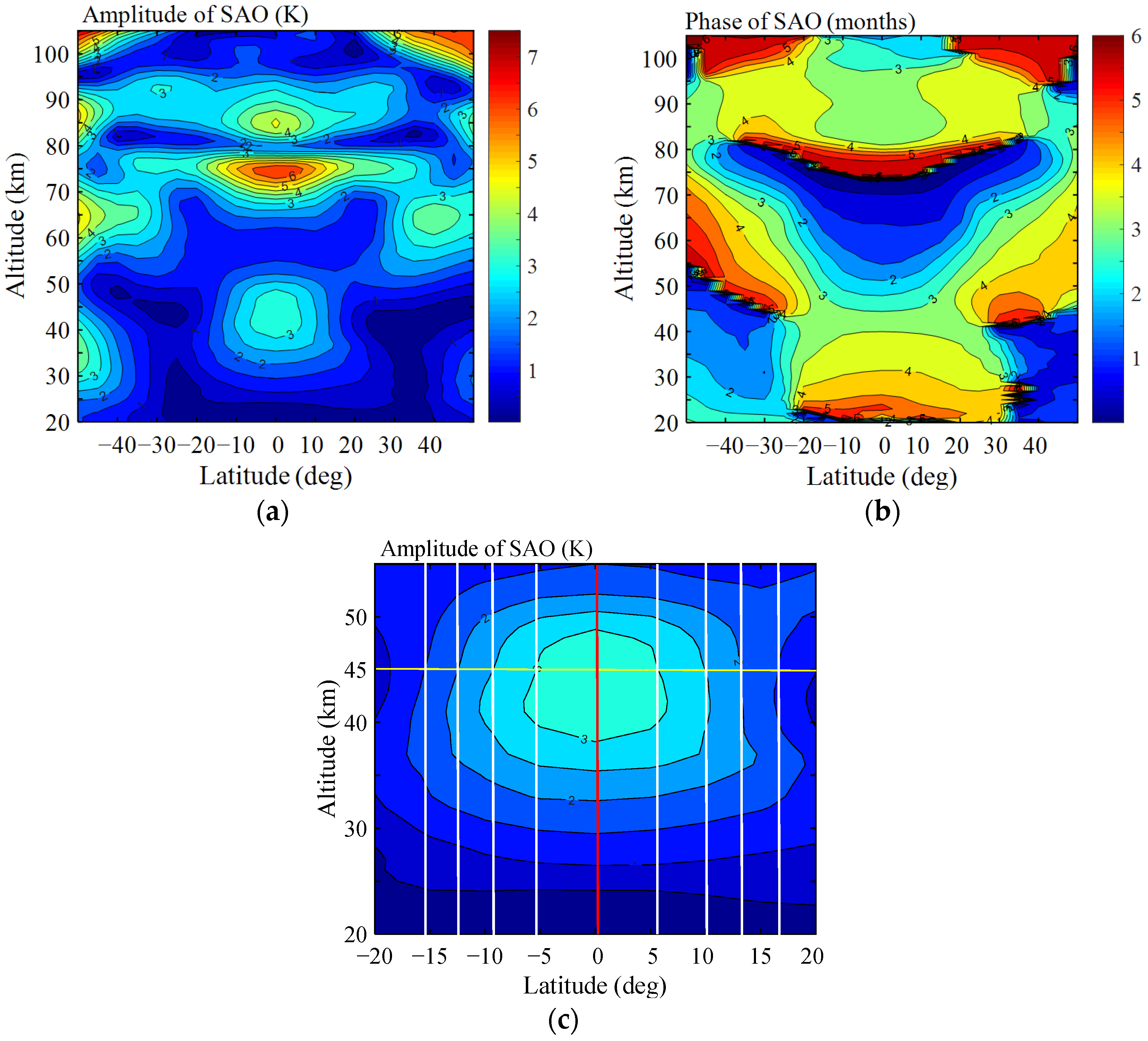
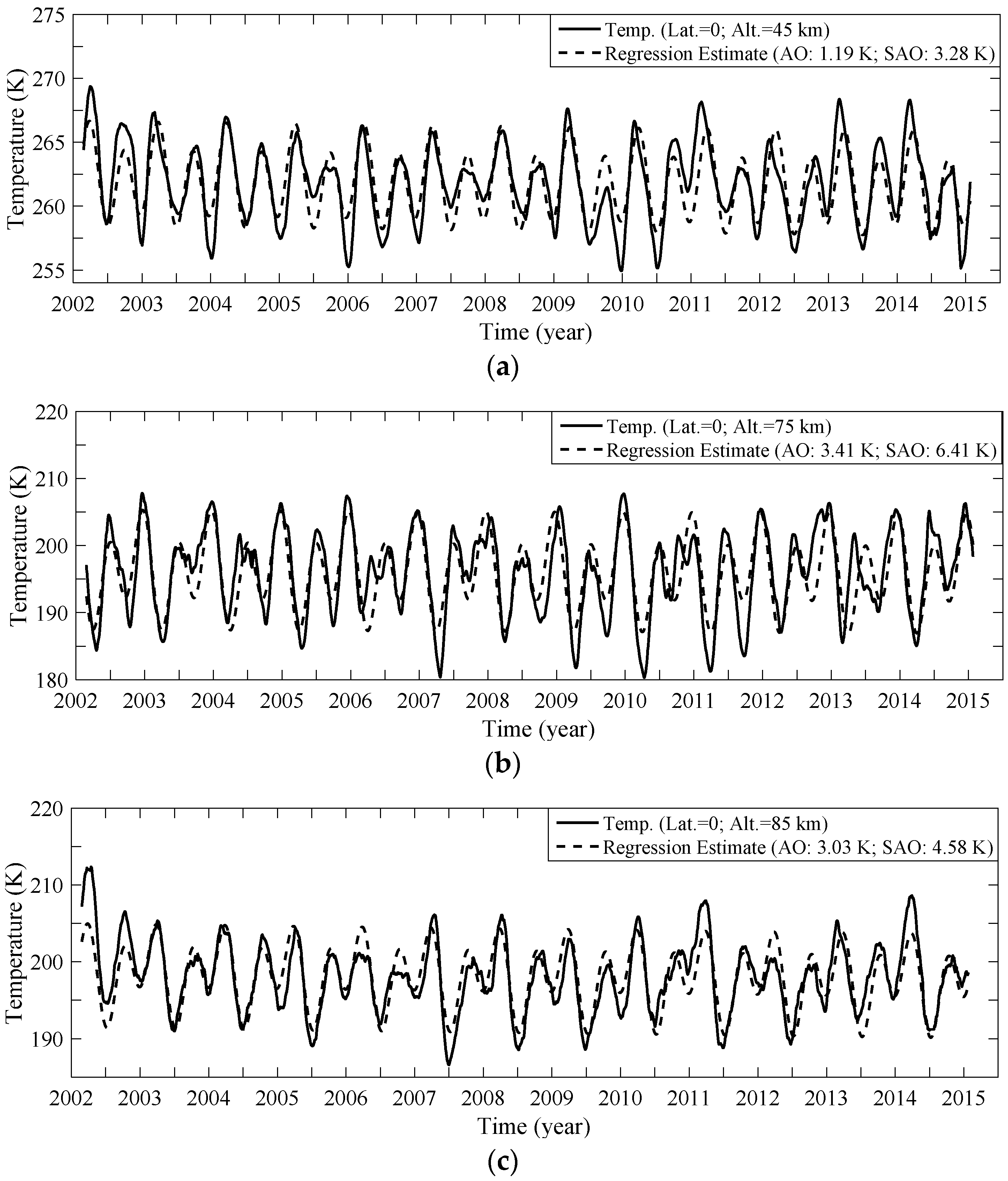


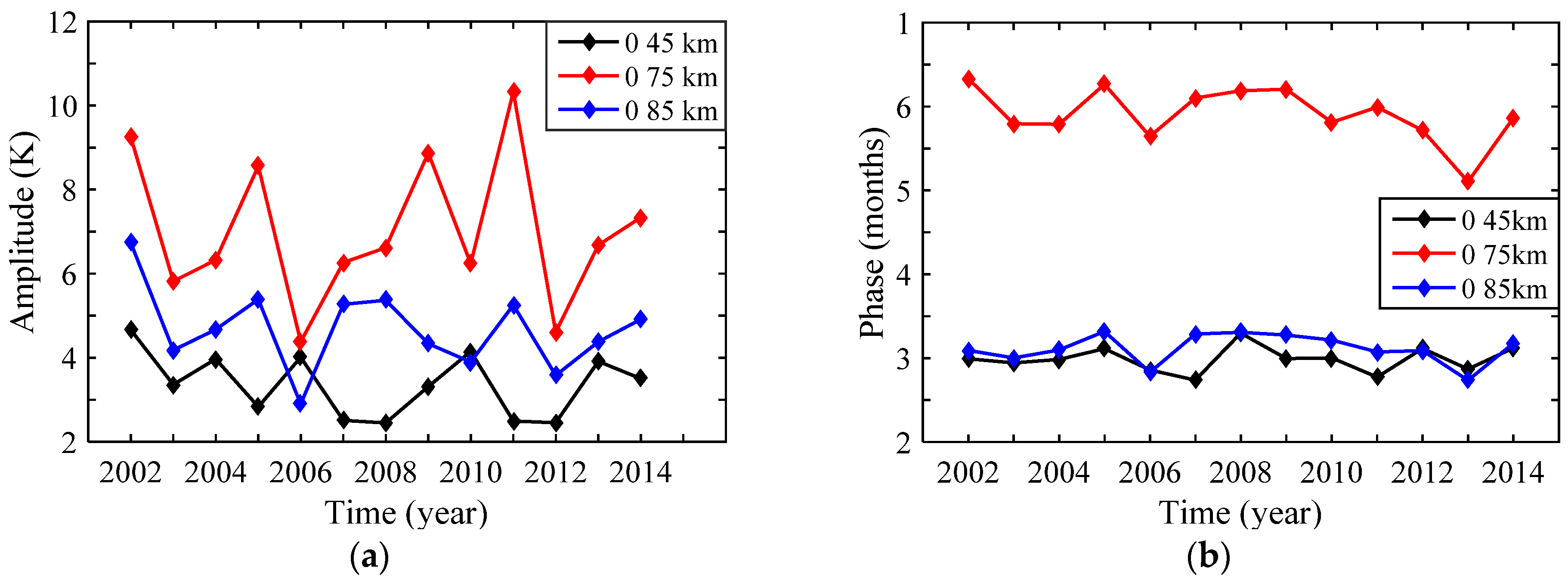
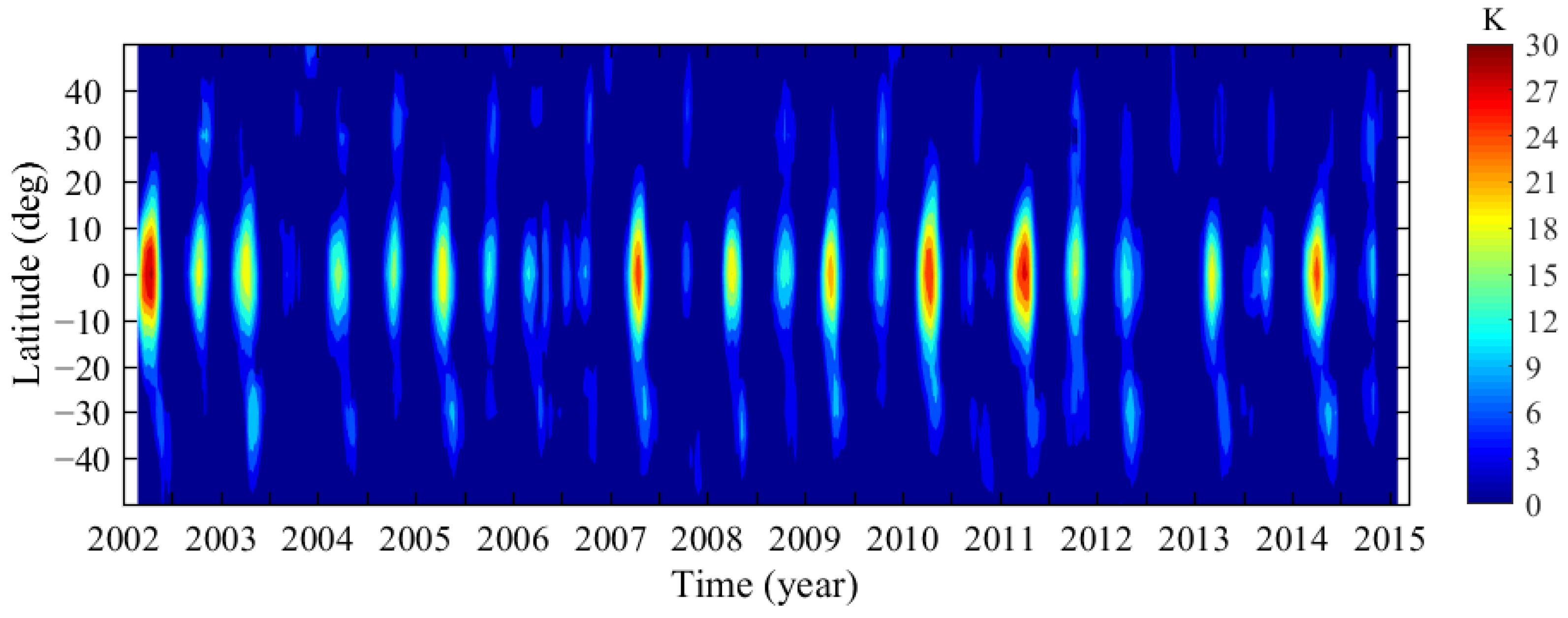

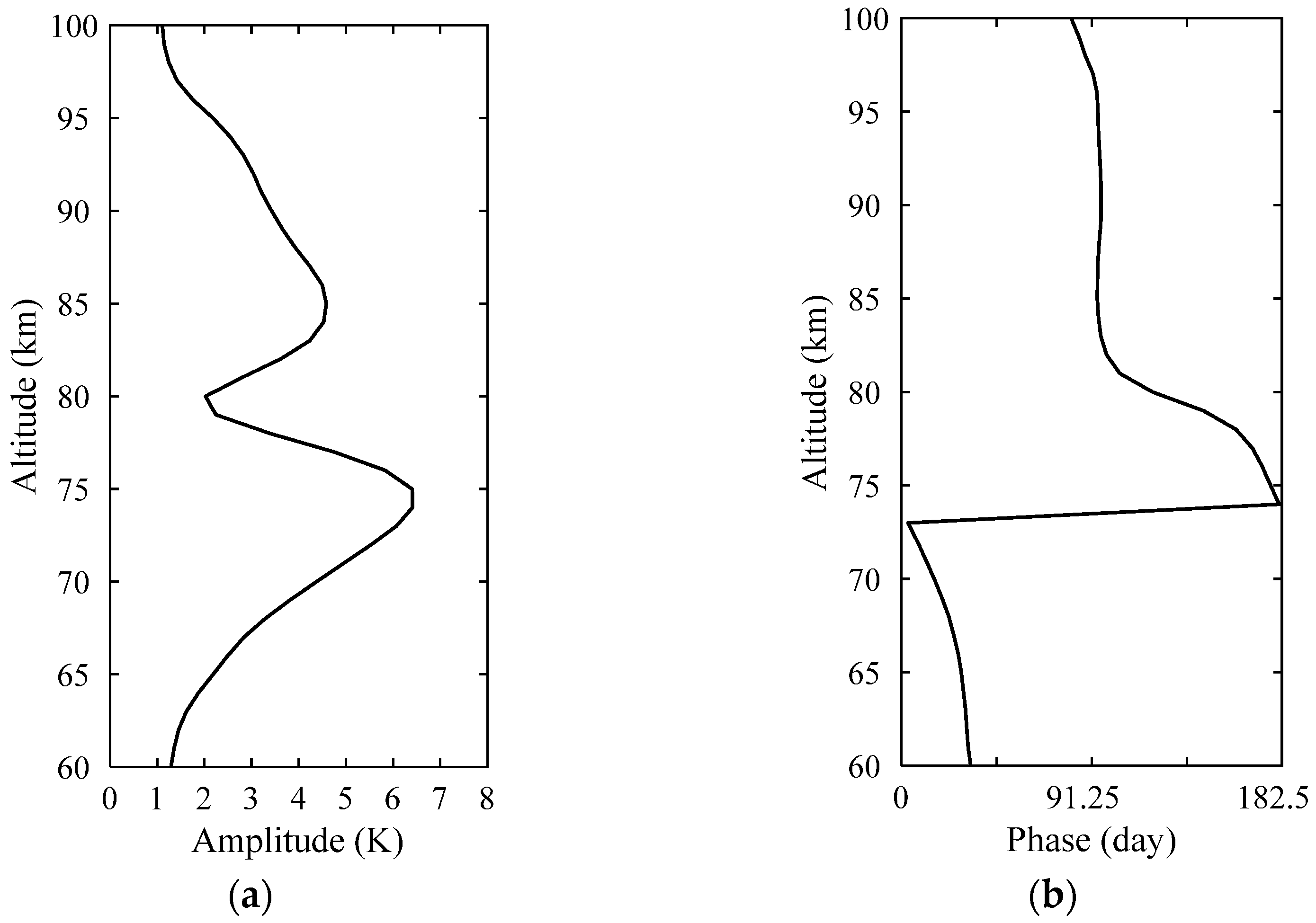
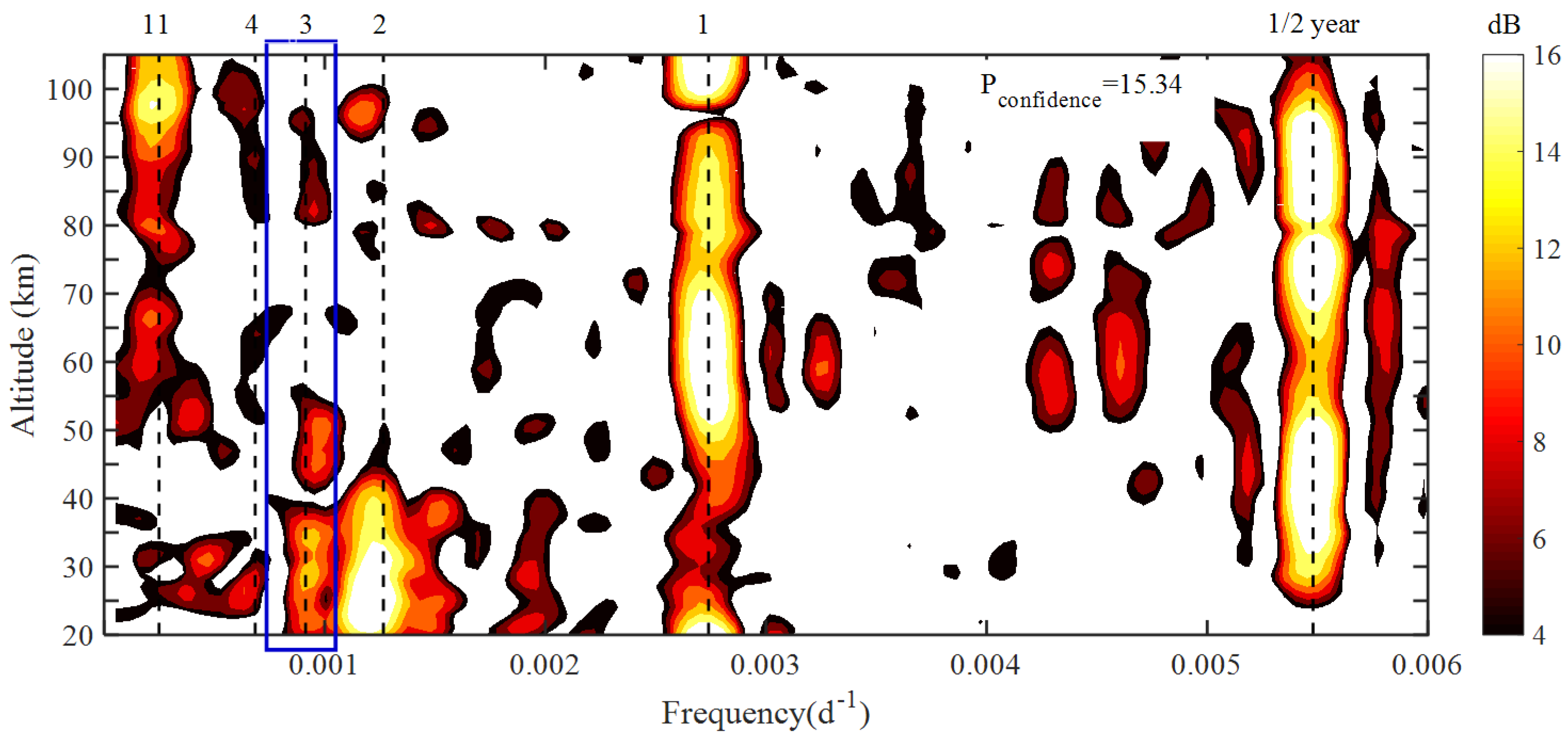
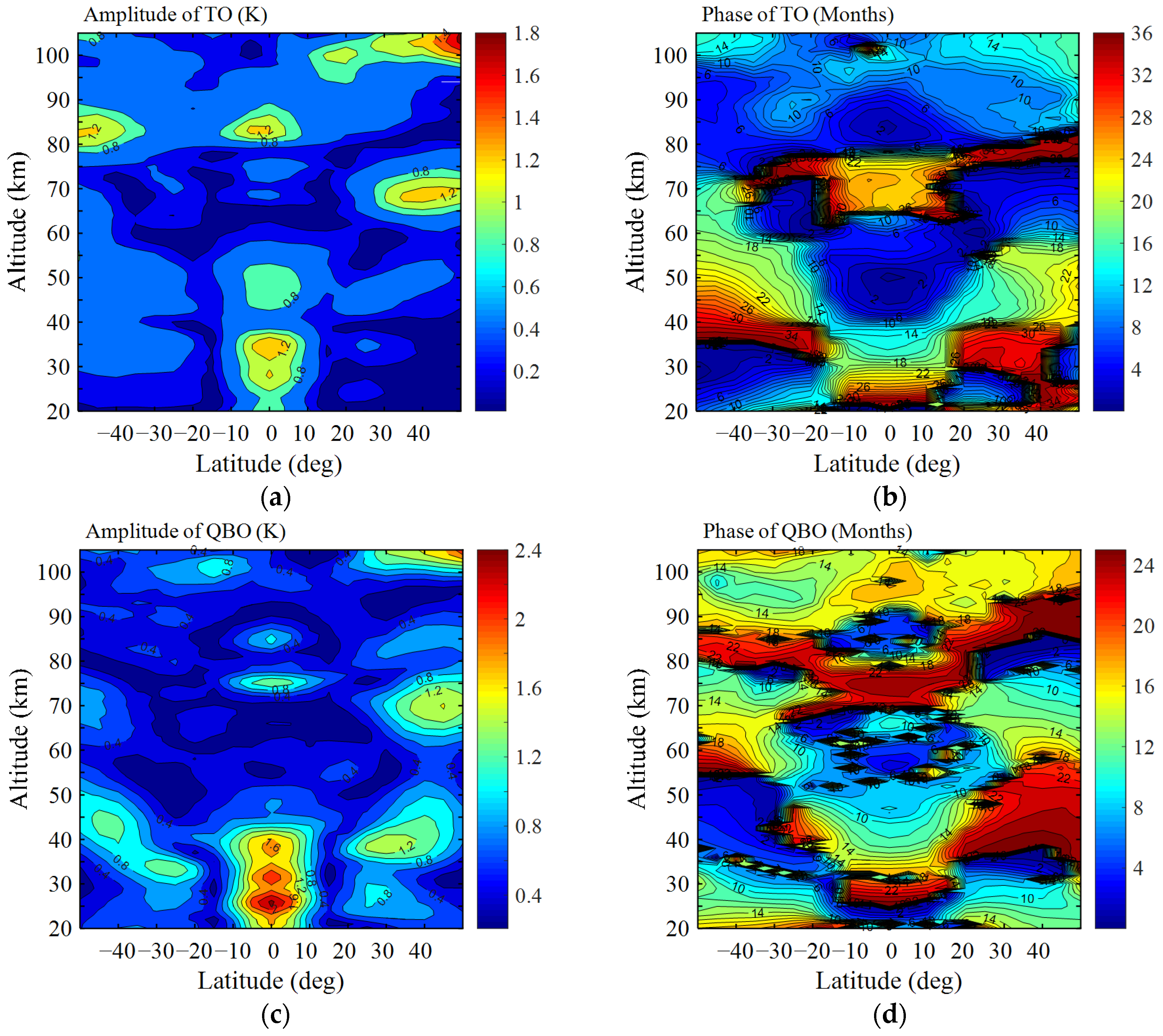

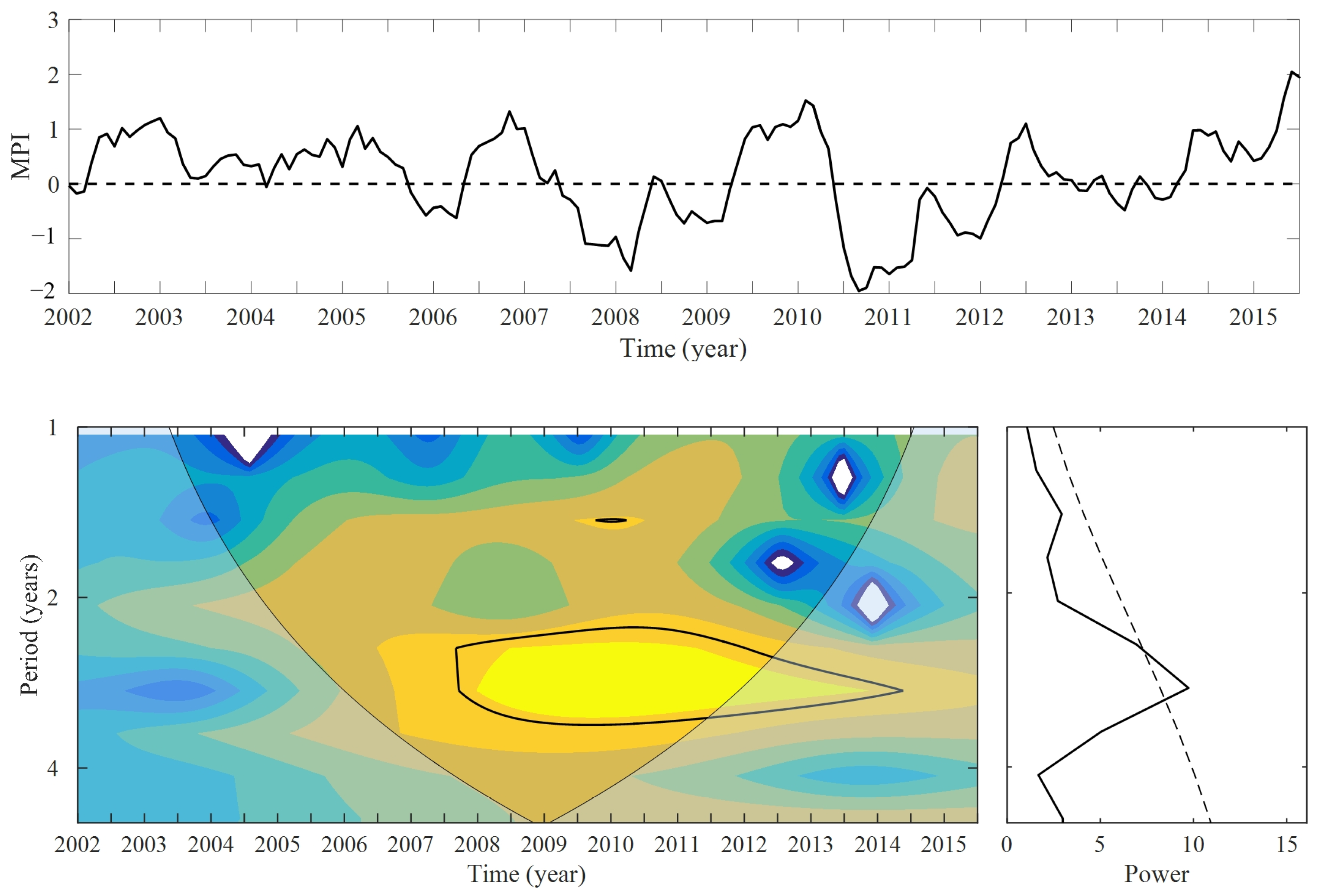
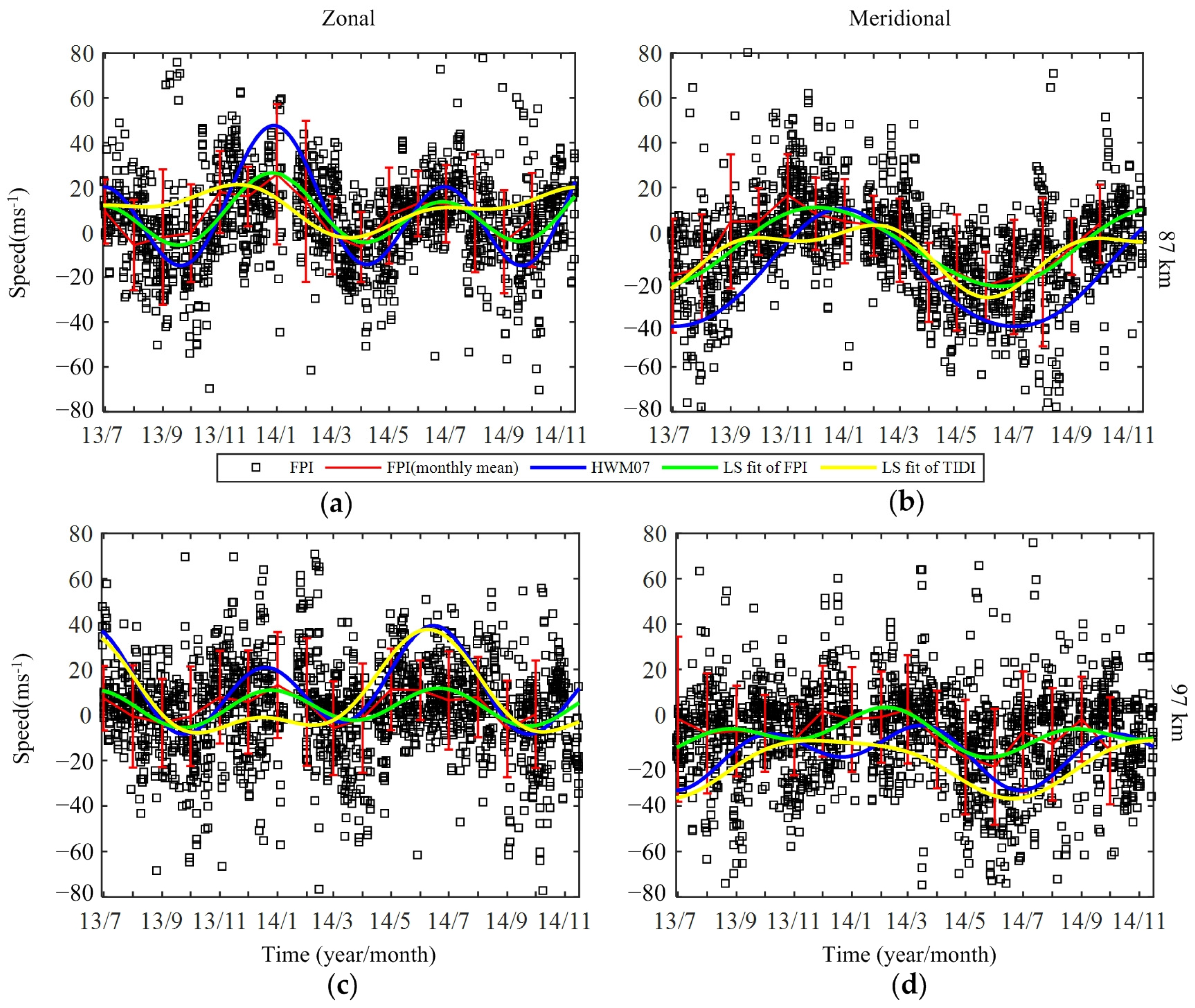
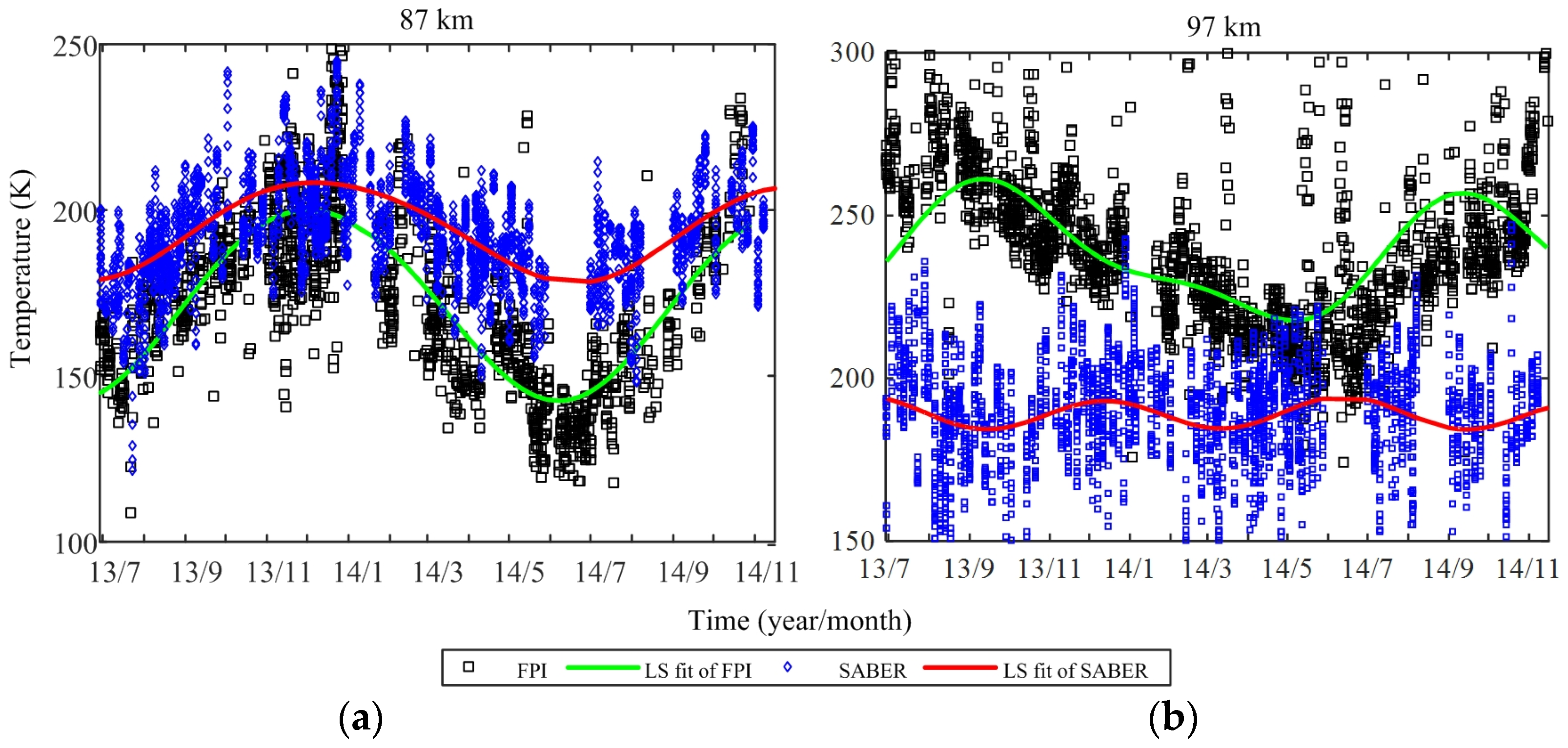
| Altitude (km) | Oscillation | Zonal Wind | Meridional Wind | ||||||||||
|---|---|---|---|---|---|---|---|---|---|---|---|---|---|
| Amplitude (ms−1) | Phase (DoY) | Amplitude (ms−1) | Phase (DoY) | ||||||||||
| FPI | HWM | TIDI | FPI | HWM | TIDI | FPI | HWM | TIDI | FPI | HWM | TIDI | ||
| 87 | AO | 6.9 | 13.7 | 8.6 | 358.1 | 359.1 | 282.6 | 17.4 | 26.4 | 13 | 339.4 | 359.1 | 342.3 |
| SAO | 12.1 | 23.9 | 5 | 179.2 | 181.4 | 159.1 | 1.1 | 2.2 | 6.8 | 107.4 | 180.6 | 59 | |
| 97 | AO | 1.5 | 9.5 | 19.4 | 185.9 | 157 | 157.3 | 6.3 | 7.6 | 12.5 | 4.9 | 9.6 | 350.1 |
| SAO | 7.6 | 17.6 | 9.7 | 175.2 | 169.4 | 162.9 | 6.3 | 9.2 | 2.9 | 45.3 | 86.3 | 85.2 | |
| Altitude (km) | Oscillation | Temperature | |||
|---|---|---|---|---|---|
| Amplitude (K) | Phase (DoY) | ||||
| FPI | SABER | FPI | SABER | ||
| 87 | AO | 14.8 | 28.7 | 339.7 | 349.5 |
| SAO | 1.3 | 1.4 | 79.4 | 92.7 | |
| 97 | AO | 17.6 | 0.7 | 272.1 | 334.2 |
| SAO | 6.2 | 4.6 | 62.7 | 162.5 | |
© 2017 by the authors; licensee MDPI, Basel, Switzerland. This article is an open access article distributed under the terms and conditions of the Creative Commons Attribution (CC-BY) license (http://creativecommons.org/licenses/by/4.0/).
Share and Cite
Zhang, Y.; Sheng, Z.; Shi, H.; Zhou, S.; Shi, W.; Du, H.; Fan, Z. Properties of the Long-Term Oscillations in the Middle Atmosphere Based on Observations from TIMED/SABER Instrument and FPI over Kelan. Atmosphere 2017, 8, 7. https://doi.org/10.3390/atmos8010007
Zhang Y, Sheng Z, Shi H, Zhou S, Shi W, Du H, Fan Z. Properties of the Long-Term Oscillations in the Middle Atmosphere Based on Observations from TIMED/SABER Instrument and FPI over Kelan. Atmosphere. 2017; 8(1):7. https://doi.org/10.3390/atmos8010007
Chicago/Turabian StyleZhang, Yiyao, Zheng Sheng, Hanqing Shi, Shudao Zhou, Weilai Shi, Huadong Du, and Zhiqiang Fan. 2017. "Properties of the Long-Term Oscillations in the Middle Atmosphere Based on Observations from TIMED/SABER Instrument and FPI over Kelan" Atmosphere 8, no. 1: 7. https://doi.org/10.3390/atmos8010007
APA StyleZhang, Y., Sheng, Z., Shi, H., Zhou, S., Shi, W., Du, H., & Fan, Z. (2017). Properties of the Long-Term Oscillations in the Middle Atmosphere Based on Observations from TIMED/SABER Instrument and FPI over Kelan. Atmosphere, 8(1), 7. https://doi.org/10.3390/atmos8010007





